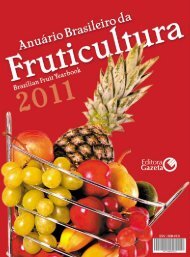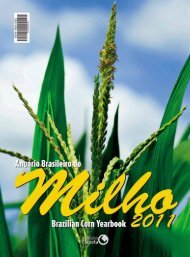tradicionalmenteinovador - Brazil Buyers & Sellers
tradicionalmenteinovador - Brazil Buyers & Sellers
tradicionalmenteinovador - Brazil Buyers & Sellers
Create successful ePaper yourself
Turn your PDF publications into a flip-book with our unique Google optimized e-Paper software.
Unproductive<br />
>> Post-harvest losses amount to 35%, on average,<br />
over the total production volumes in the Country and<br />
constitute a major problem calling for a solution<br />
One of the challenges of the vegetable sector in <strong>Brazil</strong><br />
is the problem of post-harvest losses. According to Juliana<br />
Sanches, researcher for the Automation and Engineering<br />
Center at the Agronomic Institute of Campinas (IAC), studies<br />
point to average post-harvest losses of 35%, reaching<br />
40% in some circumstances, while in other countries, like<br />
the United States, these losses barely reach 10%. “The significant<br />
amounts that are lost could supply 29.3% of the entire<br />
<strong>Brazil</strong>ian population”, she notes.<br />
According to the researcher, at field level these wastes<br />
amount to 10%, while at handling and transportation they<br />
might rise to 50%. “Transportation losses vary in accordance<br />
with the seasons of the year, and are more intense during<br />
rainy periods”, she explains. “Roads in poor conditions, along<br />
with high temperatures throughout the Country, speed up<br />
the deterioration process even further”, she observes.<br />
The list of damages does not stop there and continues<br />
throughout the Trading and Supply Centers, responsible for<br />
30% of the amounts that end up in the waste basket. Supermarkets<br />
and consumers, in turn, are responsible for 10% of<br />
the losses. “Collective meal sectors, including restaurants, industrial<br />
dining halls, fast-food chains, hospital dining halls<br />
and school meals account for 15% of the losses, caused by<br />
poor handling operations caused by poorly trained employees”,<br />
the specialist adds.<br />
In an attempt to avoid these losses, Juliana insists that,<br />
during the development stage of the crop, all management<br />
cares must be complied with. The optimum harvesting point<br />
must be respected and it varies in accordance with the cultivar,<br />
climate and soil conditions. Regarding the leafy vegetables,<br />
the lushly developed leaves (near senescence) should<br />
not be harvested because of their high content of fiber, and<br />
little pleasing taste, which is frequently characterized by a<br />
bitter flavor and hardened leaves.<br />
The researcher also maintains that harvesting should<br />
predominantly be conducted during the fresh hours of the<br />
day and as fast as possible. “It is very relevant to recall that<br />
improper handling, pre-hygienization, inadequate transportation<br />
to the processing unit could jeopardize the quality<br />
and the safety of the product, triggering the growth of<br />
the initial population of microorganisms”, she warns.<br />
>> COMPLYING WITH THE SCRIPT<br />
Regarding the post-harvest stage, in the words of<br />
80





